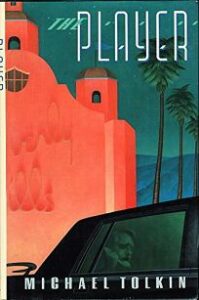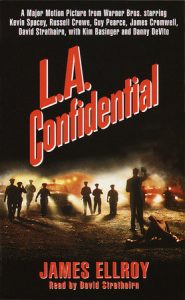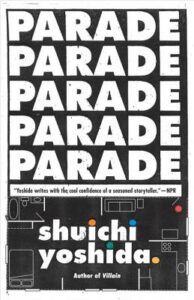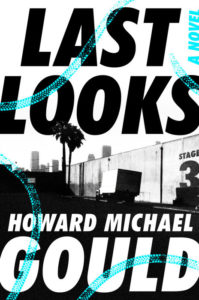The film industry has long provided a grisly backdrop for authors. A world of rags-to-riches and sudden reversals; glamour and seediness; eccentricity and charm—cinema and its players are perfect fodder for the criminally inclined.
And it’s not just Hollywood. Around the globe writers have killed, maimed, kidnapped, or ransomed with abandon the glitterati and their supporting cast.
Throughout these novels, certain tropes repeat themselves, regardless of a writer’s nationality. Beautiful starlets who are either innocent dupes or promiscuous mantraps; artistic integrity squandered or sold to the highest bidder; shady financiers and thuggish studio execs; rogue cops and disillusioned private detectives. And just as often—a profound love of, and fascination with, the moving image.
Here’s a look at 10 Entertaining Crime Novels.

The Little Sister by Raymond Chandler (1949)
A founding father of the hard-boiled school of detective fiction, Raymond Chandler created a character in Philip Marlowe—the private investigator with an office on Hollywood Boulevard—that became an icon of 20th century American literature and film.
Living in LA, Chandler began to write for pulp fiction magazines to make money during the depression. He was fifty-one when he published his first Marlowe novel, The Big Sleep. The literary success of his books, and the ensuing film adaptations, led to demand for him as a screenwriter.
Chandler is well-known for his collaborations with Billy Wilder on movies such as Double Indemnity. Having spent much of his adolescence in England, Chandler’s sense of formality and manners put him at odds with the brashness and phoniness he found in Hollywood, and in Wilder personally, leading to an intense dislike of his writing partner.
The Little Sister, the fifth of his seven Marlowe books, is considered a masterpiece; a serious work of literary fiction that also happens to be a mystery. The novel is set in the fictional town of Bay City (modeled on Santa Monica) in the 1940s. Marlowe’s case centers on the younger sister of a Hollywood actress, and it leads him into encounters with gangsters, corrupt police, seedy starlets and an elderly studio mogul who lays bare the secrets of the movie business.
His love/hate relationship with LA—a city he portrayed throughout the series as corrupt, decadent, violent and lost—and the bitterness of his film industry experience are evident in the novel’s action, as well as the disillusioned romanticism of his trademark dialogue.
There’s also a lot of ice pick stabbing action. One can only imagine Chandler grasping the heel of an imaginary stiletto or pick as he typed away, images of Billy Wilder and Paramount executives dancing in his head.

The Player, Michael Tolkin (1988)
From the school of write what you know, Michael Tolkin was born into the entertainment industry, a studio executive/film industry lawyer in the title role of mother, and the late comedy writer Mel Tolkin as the father.
A resident of LA, Tolkin has written several screenplays including the 1992 adaptation of his own novel, The Player, considered by many to be director Robert Altman’s best film, starring Tim Robbins, Greta Scacchi, Whoopi Goldberg, and Peter Gallagher. It was nominated for an Oscar (Best Adapted Screenplay) and won the Edgar Award.
The Player is the story of a Hollywood studio executive who kills an aspiring screenwriter he believes is sending him death threats. How dare such a peon threaten protagonist Griffin Mill’s ascent to the top of the heap, fueled by power lunches, pitch meetings and anxious political maneuvering?
Except maybe our boy hasn’t gotten it quite right. With biting satire, the story follows Griffin’s attempts to uncover the person sending him postcards, protect his position at the studio, evade arrest for murder and romance the dead man’s girl.
It’s clear that both Tolkin, and director Robert Altman, share disdain for a protagonist not powerful enough to greenlight a film, but who ruins lives with his ability to say no. It’s a deadly funny murder-mystery satire of Hollywood’s paranoia and duplicity that Tolkin revisits eight years later in The Return of the Player.
“He wanted to stay in this mode forever, always at a short distance from himself, where he could admire the craftsmanship of his being, every gesture, every word, each shift of energy a calculation.” How many of us haven’t imagined our life as a movie? But perhaps one without the strangulation. . .

LA Confidential by James Ellroy (1990)
James Ellroy’s life itself is a Hollywood crime novel, and in fact his origin story was borrowed by writer Michael Connelly for his Harry Bosch series of books.
Ellroy is a LA native, whose father was the one-time business manager of Rita Hayworth and whose mother was raped and murdered when he was 10. Ellroy’s memoir, My Dark Places, doubled as a true crime exploration of his own mother’s murder for which no-one has ever been charged.
Growing up, he conflated that death with the infamous ‘Black Dahlia’ case which has been referenced in many books and movies. Elizabeth Short was a beautiful young starlet murdered in 1947, her body cut in half and discarded in Los Angeles, in a notorious and unsolved crime.
After stints in the army, on the streets, in jail and as a golf caddy, Ellroy eventually found success as a writer, inspired by reading Dashiell Hammett and Raymond Chandler. (Many of us mystery/crime writers, including Michael Connelly, did the same.)
L.A. Confidential is the third in Ellroy’s L.A. Quartet—film-noir crime fiction set around Los Angeles from the 1940-60s, the period when the city grew the fastest. The plots are dense, and the world view is pessimistic. The novel explores the intersection of two violent worlds: Hollywood and the LAPD, following three policemen as they tackle the corruption surrounding a grisly unsolved massacre at a downtown LA diner.
Ellroy wrote a second LA Quartet, a prequel involving some of the characters, set during World War 11. Two of the three have been published to date (Perfidia in 2014 and This Storm in 2019). And his latest book Widespread Panic, published this year, is based on Hollywood fixer Freddy Otash, the malevolent monarch of the 1950s L.A. underground, and his Tinseltown tabloid Confidential magazine.
“L.A. shimmers out there as the last resort,” author Michael Connelly once said. “There’s a constant friction there between the haves and the have-nots, and it’s out of such tension that fiction can rise.”

Get Shorty by Elmore Leonard (1990)
Who doesn’t love themselves a little Chilli Pepper?
Hollywood may be a town of dream-makers, hucksters, and liars, but that’s exactly why small-time loan shark Chili Palmer likes it. Well, that and the scantily clad women. And the fact it’s not Miami, where his friends and acquaintances have a bad habit of showing up dead.
After a run-in with mobster Ray “Bones” Barboni, Chili travels to Las Vegas in pursuit of a client who puts the dead in deadbeat. He takes a collection job which requires him to go to LA after Harry Zimm, a horror film producer. Besides, Chili’s got himself an idea for a killer movie; where better to pitch it?
Unlike noir novels, there’s no melodrama and no disillusioned romantic heroes here, spitting out lines so pared down they’re exclamation marks. Leonard’s dialogue is realistic, his writing style free and easy, and his characters are so funny you adore them, even when they’re shooting someone in the chest, or kneecapping them for info.
More than thirty novels have been made from Leonard’s novels including the terrific adaptation of Get Shorty, starring John Travolta, Danny DeVito, Renee Russo, and Gene Hackman.

The Director’s Cut (2000) and Antwerp (2005) by Nicholas Royle
Nicholas Royle is English novelist, editor, publisher, literary reviewer, and creative writing lecturer.
Set in London, The Director’s Cut is a love letter to film—eccentric filmmakers who experiment with the art form, art critics and art lovers, film settings and those glorious old movie houses where they’re projected. . .
The plot: four young men decide to capture a dying projectionist’s last hours on camera. His body is discovered years later during demotion work on the side of a former cinema north of Soho, wrapped in the 16mm print of British filmmaker Nicolas Roeg’s Bad Timing that was used to kill him. The discovery brings together the former friends, haunted by the film they once worked on.
CUT TO: a murder inquiry and a fateful chain of events which unravels our narrator’s lives. The novel is jammed full of film trivia and cinematic references which act as clues to what really happened the night the projectionist died.
The Director’s Cut seems like a novel inevitably destined for celluloid, but a planned adaptation never transpired. Royle did write a sequel, Antwerp, another literary thriller set behind the scenes of the film industry, this time in Belgium.
Independent US film director Johnny Vos is shooting a low-budget biopic about Belgian surrealist artist Paul Delvaux. Two of his extras (both prostitutes) are murdered. English film critic Frank Warner—a repeat character from The Directors Cut—is in town to interview Vos. He gets pulled into the investigative hunt when his when his own girlfriend goes missing.
Like Royle’s earlier book, Antwerp is full of movie references. Antwerp’s underbelly is so vividly written you feel like you’re inside a cinematographer’s head.

Parade by Yoshida Shuichi (2002)
This debut novel by one of Japan’s most popular writers is more accurately described as a slow burn psychological thriller, although a crime shocks towards the very end.
Parade is one of the relatively few Japanese novels that actively use the film industry as a setting, exploring the darker side of the entertainment business.
In a cramped Tokyo apartment, four Japanese flatmates in their 20s wait for their lives to begin—hanging out, watching films, eating takeout food—while their dreams of success and romance slip away.In a crowded two-bedroom apartment in Tokyo, four Japanese twenty-somethings are waiting for their lives to begin. They have come from all over Japan, bringing with them dreams of success and romance, but life isn’t exactly going as planned. Kotomi waits by the phone for a boyfriend who never calls, Ryosuke is sleeping with his best friend’s girlfriend, and Mirai’s drinking has become a serious problem. Only Naoki, an aspiring filmmaker and the glue that keeps them all together, seems to be on the right track. Meanwhile, their next door neighbors are up to something suspicious, and a mysterious attacker is terrorizing the neighborhood.
When a homeless teenager suddenly appears, his arrival sets off a chain of events that will bring to light dark secrets the tenants of Apt. 401 have kept from one another—and from themselves.
The eldest, Naoko, gets increasingly frustrated as he struggles to make a career as a film distributor, and instead finds himself working long hours chained to a desk and forced to compromise his artistic vision for commercial reasons. The picture Shuichi draws of the indie film business is bleak, and ultimately Naoki is consumed by a violent epiphany when he’s left behind while his colleagues party it up in Cannes.
Meanwhile, there’s something suspicious happening with the next-door neighbors, and a mysterious attacker terrorizes the neighborhood. Suddenly, Satoru, a teenage street hustler, appears and unbalances the delicate détente of the apartment. Secrets, previously held fast, bubble to the surface.
The novel is told chronologically in five sections, each with a different narrator (the four roommates plus Satoru) and each new perspective reveals more about the characters and the increasingly fraught domestic world they share. Sometimes, the biggest threats we face are from those held closest.

Mary Mary, James Patterson (2006)
In this novel, Cross is on vacation with his family and girlfriend in Disneyland when he gets a call from the FBI Director. A well-known actress has been shot and her face viciously slashed outside her home in Beverly Hills. Soon, a LA times editor receives an email describing the murder is minute detail and Cross learns the murder is not an isolated incident. ‘Mary Smith’ has killed before and has no plans to stop.
Additional victims, including a movie producer and TV anchor, turn up. Who is murdering Hollywood’s A-List? The LAPD and FBI work feverishly to find a pattern before another Hollywood heavyweight bites the dust.

What Remains of Me by Alison Gaylin (2016)
What Remains of Me shifts between 1980 when seventeen-year-old Kelly is convicted of killing Oscar-nominated director John McFadden, and 2010 when her now father-in-law, movie legend Sterling Marshall, is found shot in his Hollywood Hills home in the same fashion as his old friend McFadden.
One to the head.
Never willing to let a crisis go to waste, the paparazzi descend on Kelly’s enigmatic ‘Mona Lisa smile,’ making her a cause célèbre for all the wrong reasons. The new Charles Manson! A female Ted Bundy! Speculation runs rampant for years about why Kelly killed McFadden—information she refuses to share.
Jump-cut to 2010. Kelly’s been out of jail for five years and is suspected of murder once again. But is she innocent of one or either or both? The duo-narrative moves effortlessly back and forth, building subtle connections and playing twister amongst the possibilities, until the peeled back layers reveal the truth.
Gaylin, a former New York Post entertainment journalist, inserts a chilling commentary into the novel about public perception of guilt and the culpability of flashbulb media who feed on sensational crimes.

Last Looks by Howard Michael Gould (2018)
This is a razor sharp, hugely funny debut novel that lampoons Hollywood culture and introduces the eccentric, yet brilliant ex-detective gone rogue: Charlie Waldo. One a LAPD star, Charlie now lives a pared down existence in the woods, committed to reducing his carbon footprint by possessing no more than 100 possessions at any given time.
Charlie’s self-imposed exile comes to a halt when he is roped back into a case by Lorena, the girlfriend he left behind. The wife of an eccentric TV star has been murdered. But Charlie’s out of practice when it comes to detecting or even dealing with other people and besides, there’s a whole lot of assailants who wish him harm.
Howard Michael Gould is a playwright, screen writer and TV executive producer. The second in this new series was published in 2019, and Waldo #3 drops December 2021.
Like Gould, and the other authors, I was drawn to set my debut novel, Pull Focus, behind the scenes of an industry which fascinates billions of people around the world. And like them, too, my experience working as a film producer resulted in the novel combining a sharp satire about industry machinations with a deep love of the art form.
Extreme personalities, huge money at stake, the world watching – how could it not be a fascinating setting in which to drop a murder or two and see what happens?
***


















